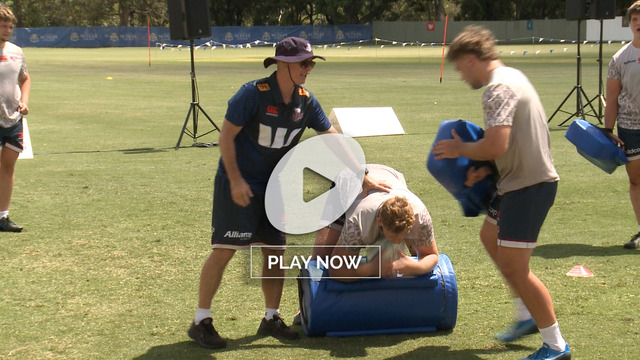Why you have to go long in order to get wide
Before the start of the ground-breaking Super Rugby Aotearoa competition in 2020, a host of stringent new breakdown protocols were introduced at the breakdown. They produced their share of problems initially, as the players struggled to adjust to the greater demands and a quicker tempo of attacking play.
A neat summary of the changes, laid out by New Zealand Rugby Referee Manager Bryce Lawrence and current professional referee Paul Williams, can be found here
The main thrust of the new protocols was the need to produce either quicker ball for the attack, or an immediate turnover for the defence. Therefore, tacklers were required to get out of the space between the ball-carrier and the acting scrum-half faster (on defence), and the tackled player was asked to release the ball without making an extra movement on the ground.
The shape of the new game is still emerging, but there is strong evidence that the smarter attacking teams are working out how to create an advantage under the new rules.
One key ingredient in the ability to create attacking width, is a long placement of the ball by the tackled player on the previous phase. Let’s look at a couple of examples from the first round of Super Rugby Aotearoa, from the clash between the Crusaders and the Highlanders at Forsyth Barr stadium in Dunedin.
I have split the first sequence into two parts:
The ball-carrier on the first phase is the Crusaders’ Scott Barrett. As soon as he hits the deck, Barrett makes a different move to the one he might have made two seasons ago. Instead of trying to make a second roll on the ground, or tucking the ball underneath his body for maximum protection, he makes a very long and immediate presentation of the ball:

Look the situation he has created. Two Highlanders forwards (number 3 and 4) now have to move back towards their own goal-line before they can become a factor in the next phase. The Highlanders defender at the back of the ruck (Aaron Smith) also takes a step up to fill the hole which has appeared on the right of ruck, and that takes him away from the subsequent direction of attack:

The shot widens to reveal a pleasant scenario for the attack – a numbers advantage (three on two) with the last two Highlander defenders having to defend wide line splits to either side. The defender inside the Highlanders left wing is a forward (the number 8) and that also promises to increase the advantage for the Crusaders:
The Crusaders number 14 (Sevu Reece) is able to cut back inside two Highlander forwards to make the break and ship the ball on to prop Joe Moody. Moody also makes an instant long release on the floor to continue momentum.
It is at this stage that it becomes apparent that refereeing interpretation of the new rules is not entirely consistent:

Referee Ben O’Keefe allows the Highlanders’ number 7 to compete for the ball without showing a clear release of the ball-carrier (“Assist tackler must clearly release the ball carrier”). Moreover, the main tackler continues to play a role by impeding the attempted cleanout by the Crusaders’ number 9 (“To reward a jackler, the tackler must not impede the cleanout”). There is still work to be done.
The same attacking theme, of a long placement at the tackle creating width, was reinforced by another sequence in the second half of the game:
The Crusaders player makes an immediate long presentation of the ball. Both of the Highlanders’ centres have been caught around the tackle; the tackler (number 13) who would have been permitted to play at the ball from the wrong side under previous versions of the law, now has to retire behind an offside line and is out of the play:

The situation as the shot widens is very similar to the first example:

It is another four-on-two for the Crusaders on the opposite side of the field, and in the absence of both of the Highlanders’ centres, their number 8 is again to be found defending inside the left wing.
There are still problems in refereeing consistency to be ironed out, but it is becoming evident that a long and immediate placement of the ball at the tackle can go a long way towards creating instant width on a rugby field under the new rules. That presentation will catch defenders retiring towards their own goal-line and therefore out of the play, it can pull in the defensive 9 to fill holes around the ruck, and there is less chance for the defence mount a rush and prevent the ball moving smoothly to the other side of the field.













.jpg)
.jpg)





_no_button.jpg)

